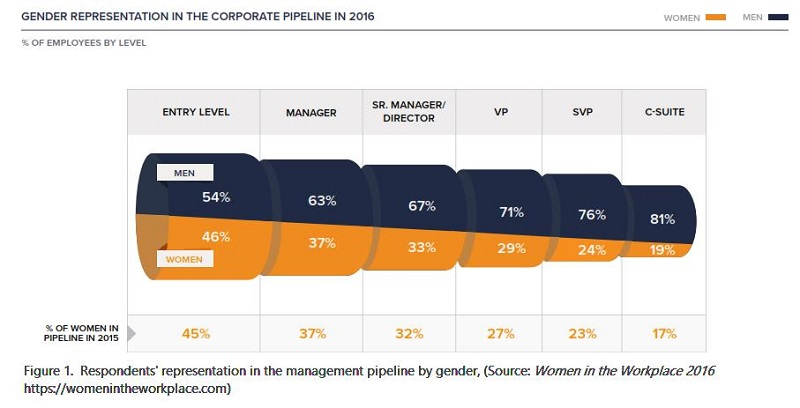ATD Blog
What's the State of Women in the Workforce?
Wed Nov 09 2016

Most women in the workforce today don’t remember that a lack of access to higher education in the past excluded them from well-paid occupations. In the 19th and early 20th centuries, women were deprived of access to many highly paid jobs by being denied admission to degree programs that would permit them to enter those occupations.
According to the Harvard Gazette, Harvard Graduate School of Education first admitted women in 1920. Its medical school accepted its first woman in 1945, and its first woman into law school in 1950. Clearly, there is a history of women having difficulties securing any job, much less high paying jobs. In some parts of the world, this is still the case.
Is the Past Prologue?
Most of us have heard philosopher George Santayana’s famous quote: “Those who cannot remember the past are condemned to repeat it.” Unfortunately, the history of women’s workplace rights isn’t simply a history of the past; it is also the present. It also predicts our history with other less-included groups.
The history of women in the workforce is a turbulent one. Women have largely had to lead the way for equal work rights and changes to the status quo. It’s remarkable that the Knights of Labor in the 1800s voted to admit women and argued for equal pay for all genders and races. But the American Federation of Labor (AFL) in the late 1800s and early 1900s didn’t support women’s rights, so those rights regressed under AFL influence. And during the Great Depression, men successfully fought against women taking what they considered to be men’s jobs.
It wasn’t until World War II, when women were needed to perform factory work done by absent men, that things began to change. As men came home from the war, men went back to their jobs and women began to enter the workforce in what were now considered female jobs, such as nursing, teaching, office work, and retail sales.
The United States has tried to legislate fairness, but legislation and results are often at odds. The Civil Rights Act of 1964 made discrimination based on race, color, religion, sex, or national origin illegal. The Equal Employment Opportunity Commission (EEOC) took employment rights further. In 1978, the Pregnancy Discrimination Act banned discrimination against pregnant women in the workplace. However, what is illegal and what occurs in day-to-day business practices can be worlds apart.
Where Are We Today?
Women in the Workforce 2016, a study of 132 companies and 34,000 employees by McKinsey & Company and LeanIn, tells us about gender practices and career issues in those companies and for those employees. Here are five of the key results of the study:
Women are less likely to have access to the people and opportunities that tend to accelerate careers.
Women are less likely to receive the first and most critical promotion to manager, so fewer end up on in the pipeline to organizational leadership.
As a result of 1 and 2, far fewer women get hired into more senior positions.
The disparities in 1 through 3 are especially pronounced for women of color. Women of color face the greatest barriers to advancement and the steepest drop-offs with seniority.
The study feels that turning commitment into results starts with better communication, more training, and less talk, more action focus.
Figure 1 shows the study respondents’ gender representation at all levels. The study makes the important point that since women are less likely to receive the first critical leadership promotion to manager (for every 100 women promoted to manager, 130 men are promoted), there will be far fewer of them to promote all along the path.

Women and men both say that sponsorship and mentoring interactions by senior leaders are critical for women gaining leadership positions but women reported far fewer of these interactions. As women and men advance, the gap widens.
A recent report by the Pew Research Center supports the findings of Women in the Workforce 2016 and provides additional insights. Using two U.S. surveys, Pew Research Center found that male and female respondents felt women were as capable as men of being good organizational and political leaders. They also observed that women and men are indistinguishable on many key leadership traits.

But just like in the Women in the Workforce 2016, the study also revealed that women don’t have access to necessary opportunities (see Figure 2).
Women and men see the issue quite differently. For example, almost two-thirds of the women respondents said women face some gender discrimination today. But slightly less than 50 percent of men said they believe women face some gender discrimination.
You might think there would be differences by political leanings. But even here, men were much less likely to see disparities. About half of Republican men said the country had made the changes needed to give men and women equality in the workplace. But about two-thirds of Republican women say more changes are needed. Among Democrat men, less than half said they hoped to elect a women president in their lifetime while almost 70 percent of Democratic women said they hoped to elect a women president in their lifetime.
Where Does This Leave Us?
The Women in the Workforce 2016 study shows actual disparities in promotions. A study of the Department of Labor’s affirmative action mandate showed that women held fewer than 3 percent of the skilled trades jobs and apprenticeships, 12 percent of police officer’s jobs, and a tiny fraction of construction jobs. The report also showed considerable gender discrimination and harassment in jobs that are considered to be traditional blue-collar men’s jobs. This report also revealed patterns of harassment of women in these fields and questioned whether women self-selected out of them as a result.
The Elephant in the Valley project asked 200+ women with at least 10 years of tech work experience mostly in the San Francisco/Silicon Valley area, to discuss their experiences. It too showed harassment and discrimination. Almost all respondents had been told they were too aggressive and close to half felt excluded from typical social experiences that were critical to gaining opportunities to being involved in decision making. Many said that they were asked to do lower-level tasks that male colleagues weren’t asked to do. More than half reported unwanted sexual advances. The list goes on and actual stories are provided.
Women are underrepresented in the sciences and we see programs seeking to address the lack of women in STEM (Science, Technology, Engineering and Mathematics) by encouraging young women to be more involved in science and providing women science mentors. But a study in the Proceedings of the National Academy of Sciences indicates unconscious gender bias is pervasive in hiring practices, rewards, mentoring, and career advancement. Reports show similar issues with bias and discrimination in scientific fields. As a result, the lack of representation in scientific (and tech, and blue collar, and other) fields may well be due to the problems that women face in these fields.
An article in the online Smithsonian magazine (that discusses the poor representation of women in scientific fields) tells us that the gatekeepers of science, tech, organizations, politics, and so forth must recognize there IS a bias or nothing will be done and this situation will continue. Indeed, we need to have this conversation everywhere. If we fail to do so, we’re setting up women to fail and organizations to gain far less from their female workforce. It’s just that simple.
Further Reading
(n.d.) Selected timeline of women's labor history. https://libcom.org/files/US-women-labour-history.pdf
Casey, T. (2013). Still excluded: There are still virtually no women in the federally created and supervised apprenticeship system for the skilled construction trades. http://www.ncdsv.org/images/LM\_still-excluded\_3-2013.pdf
Claremont Colleges Digital Library (n.d.). Women's Employment, United States and Great Britain in the Early 20th Century. http://ccdl.libraries.claremont.edu/cdm/landingpage/collection/p15831coll7 (see also http://www.oac.cdlib.org/findaid/ark:/13030/kt0n39q1sk/)
Moss-Racusina, C.A., Dovidiob , J.F., Brescollc , V.L., Grahama, M.J. & Handelsmana,1 J. (). Science faculty’s subtle gender biases favor male students. http://www.pnas.org/content/109/41/16474.full.pdf
Parker, K., Menasce Horowitz, J., & Wang, W. (2015). Women and leadership Pew Research Center http://www.pewsocialtrends.org/2015/01/14/women-and-leadership/
Stromberg, J. (2012). Are scientists sexist? New study identifies a gender bias. Smithsonian.com. http://www.smithsonianmag.com/science-nature/are-scientists-sexist-new-study-identifies-a-gender-bias-47610982/
Vassallo, T., Levy, E., Madansky, M., Mickell, H., Porter,B., Leas, M., & Oberweis, J. (2012). The Elephant in the Valley. http://www.elephantinthevalley.com
Walsh, C. (2012). Hard-earned gains for women at Harvard. http://news.harvard.edu/gazette/story/2012/04/hard-earned-gains-for-women-at-harvard/
Yee, L. , Krivkovich, A., Kutcher, E., Epstein, B. Thomas, R., Finch, A., Cooper, & M., Konar, E. (2016). Women in the workplace 2016. LeanIn and McKinsey & Company. https://womenintheworkplace.com
You've Reached ATD Member-only Content
Become an ATD member to continue
Already a member?Sign In
